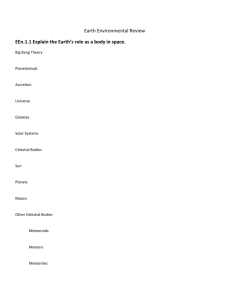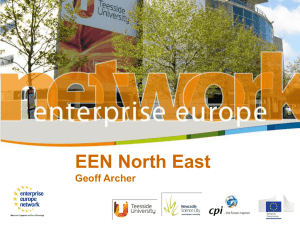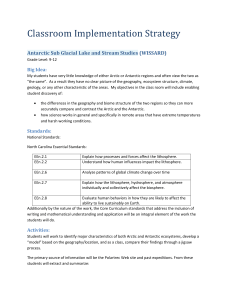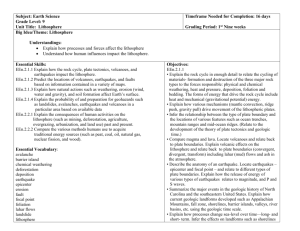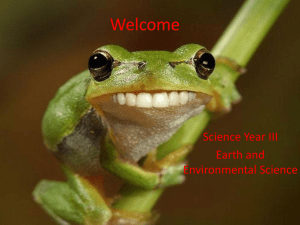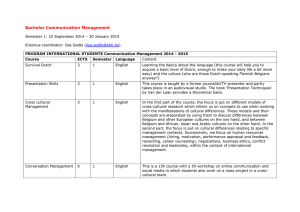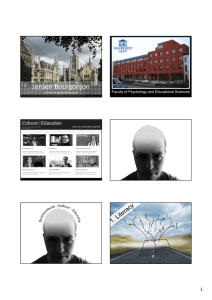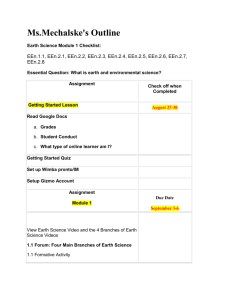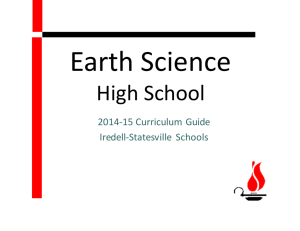Earth Science Curriculum Support Document - GCS9
advertisement
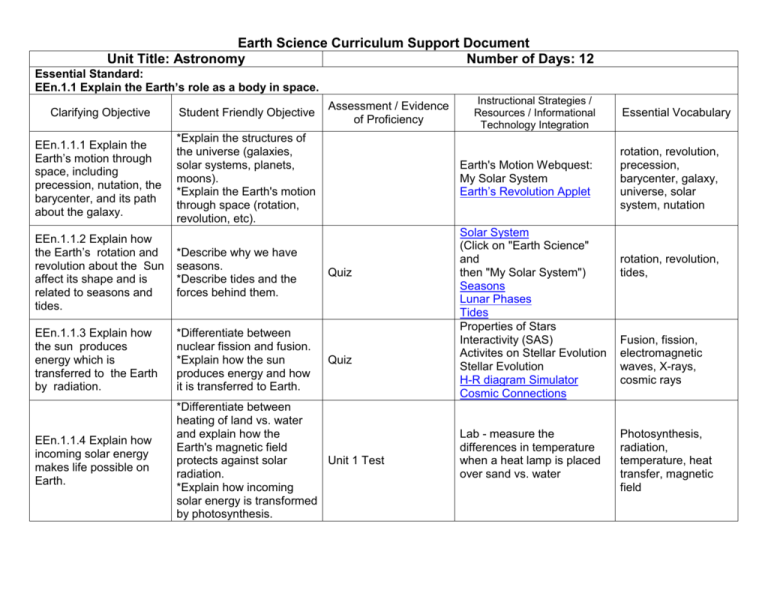
Earth Science Curriculum Support Document Unit Title: Astronomy Number of Days: 12 Essential Standard: EEn.1.1 Explain the Earth’s role as a body in space. Clarifying Objective Student Friendly Objective EEn.1.1.1 Explain the Earth’s motion through space, including precession, nutation, the barycenter, and its path about the galaxy. *Explain the structures of the universe (galaxies, solar systems, planets, moons). *Explain the Earth's motion through space (rotation, revolution, etc). Assessment / Evidence of Proficiency Instructional Strategies / Resources / Informational Technology Integration Earth's Motion Webquest: My Solar System Earth’s Revolution Applet EEn.1.1.2 Explain how the Earth’s rotation and revolution about the Sun affect its shape and is related to seasons and tides. *Describe why we have seasons. *Describe tides and the forces behind them. EEn.1.1.3 Explain how the sun produces energy which is transferred to the Earth by radiation. *Differentiate between nuclear fission and fusion. *Explain how the sun produces energy and how it is transferred to Earth. EEn.1.1.4 Explain how incoming solar energy makes life possible on Earth. *Differentiate between heating of land vs. water and explain how the Earth's magnetic field protects against solar Unit 1 Test radiation. *Explain how incoming solar energy is transformed by photosynthesis. Quiz Quiz Solar System (Click on "Earth Science" and then "My Solar System") Seasons Lunar Phases Tides Properties of Stars Interactivity (SAS) Activites on Stellar Evolution Stellar Evolution H-R diagram Simulator Cosmic Connections Lab - measure the differences in temperature when a heat lamp is placed over sand vs. water Essential Vocabulary rotation, revolution, precession, barycenter, galaxy, universe, solar system, nutation rotation, revolution, tides, Fusion, fission, electromagnetic waves, X-rays, cosmic rays Photosynthesis, radiation, temperature, heat transfer, magnetic field Unit Title: Geology Number of Days: 22 Essential Standard: EEn.2.1 – Explain how processes and forces affect the lithosphere. EEn.2.2 – Understand how human influences impact the lithosphere. Clarifying Objective Student Friendly Objective Assessment / Evidence of Proficiency Instructional Strategies / Resources / Informational Technology Integration Essential Vocabulary *Explain the rock cycle and what drives its processes. *Explain how various mechanisms drive movement of lithospheric plates. *Infer the relationship EEn.2.1.1 Explain how between the type of plate the rock cycle, plate boundary and the locations tectonics, volcanoes, and of features. earthquakes impact the *Explain volcanic effects lithosphere. on the lithosphere and how they relate to plate boundaries. *Describe the anatomy of an earthquake. *Summarize major events in the geologic history of North Carolina. rock, sedimentary rock, metamorphic rock, igneous rock, bedding, foliation, physical weathering, chemical weathering, transport, deposition, heat energy, mechanical energy, gravitational potential, mantle convection, plate boundary, convergent, divergent, transform, oceanic to oceanic, oceanic to continental, continental to continental, ocean trench, mountains, mid-ocean ridge, magma, lava, volcano, shield cone, cinder cone, composite cone, fissure, eruption, lahar, earthquake, focus, epicenter, seismic waves, P wave, S wave, magnitude, Appalachian orogeny, fall zone, Shorelines, barrier islands, migration, valleys, river basins, geologic time scale EEn.2.1.2 Predict the locations of volcanoes, earthquakes, and faults based on information contained in a variety of maps. Strike-slip fault, reverse fault, thrust fault, normal fault, soil map, geologic map, topographic map *Infer the locations of volcanoes, earthquakes, and faults from soil, geologic and topographic map studies. *Predict the locations of EEn.2.1.3 Explain how natural actions such as weathering, erosion (wind, water and gravity), and soil formation affect Earth’s surface. EEn.2.1.4 Explain the probability of and preparation for geohazards such as landslides, avalanches, earthquakes and volcanoes in a particular area based on available data EEn.2.2.1 Explain the consequences of human activities on the lithosphere (such as mining, deforestation, agriculture, overgrazing, urbanization, and land use) past and present. EEn.2.2.2 Compare the various methods humans use to acquire traditional geologic hazards on maps. *Describe the formation and composition of soil. *Explain the differences in chemical and physical weathering. *Explain how weathering rates are affected by a variety of factors. *Compare erosion by water, wind, ice and gravity on various landforms. soil, sand, silt, clay *Infer where development should take place to reduce impacts by geohazards. *Explain precautions that an be made to protect life from geohazards. *Explain the consequences of various types of land use. *Explain ways to reduce human impacts on the lithosphere and maximize sustainable use of natural resources. *Explain the effects of human activity on shorelines. *Explain the effects of human activity on mountainsides. *Compare the methods of obtaining energy resources. Landslides, earthquakes, tsunamis, sinkholes, groundwater pollution, flooding Interactive map of the beach Storm water runoff Urbanization, deforestation, agriculture, artificial stabilization Peat, wood, mining, drilling energy sources (such as peat, coal, oil, natural gas, nuclear fission, and wood).
